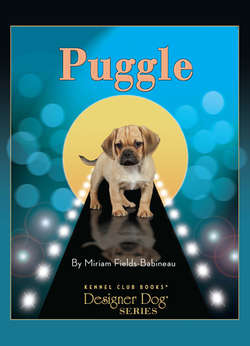Читать книгу Puggle - Miriam Fields-Babineau - Страница 14
На сайте Литреса книга снята с продажи.
ОглавлениеIf you’ve “got Puggles,” then you’ve got plenty of canine affection and fun.
Pug + Beagle = Puggle
Puggles have been around since the early 1990s, but there has not been any type of standardization of the hybrid mixture. Puggles became very popular very quickly. Hence, breeders popped up everywhere with few restrictions on or expectations of what they produced.
The intent behind the Puggle, as it is with hybrids in general, is to bring together two breeds of dog that are attractive and have appealing personalities. Many hybrids are small dogs, as people want dogs that are easily cared for in an urban or suburban environment. Other considerations include producing hybrid puppies that are unlikely to have the inherited defects so commonly found in purebred dogs.
Though Puggles have similar characteristics—most are fawn to red in color with dark faces—the Puggle cannot be considered a breed. Puggles must be created by breeding a Pug to a Beagle. Moreover, the sire must be the Pug and the dam the Beagle. Otherwise, the offspring appear more Pug-like with bulging eyes and very short noses; both of these physical constructions are prone to health problems, as the eyes are easily injured and short noses often lead to respiratory issues.
Designer dog, designer style.
COMMON PUGGLE HEALTH AILMENTS
Hip dysplasia
A painful condition in which the head of the thigh bone and the socket of the hip do not fit together properly.
Hypothyroidism
A disorder in which the thyroid gland is underactive, affecting metabolism and other body functions.
Patellar luxation
Also called “slipped kneecaps,” a condition in which the kneecaps pop out of place.
Legg-Calve-Perthes disease
A disorder of the blood supply to the head of the thigh bone, causing death of the bone and arthritis of the hip.
General eye problems
People who breed together two different breeds of dog are not only looking for a “designer-dog” appearance but also to produce a dog with fewer genetic defects. The idea is that the larger the gene pool, the lower the percentage of inherited problems. This is called the “heterosis effect,” defined as physical or mental strength, force or energy, also termed “hybrid vigor.” Though many hybrid dog breeders have been lucky with the reduction of the occurrence of genetic defects, they do still occur. Recessive genes have a way of popping up from time to time. While a good breeder will refrain from rebreeding a dog that has produced pups with genetic defects, there are many unscrupulous breeders who won’t, as they care more about cashing in on the designer-dog craze than about producing quality pups.
Puggles are active dogs, but they thoroughly enjoy relaxation time, too.
It didn’t take the Puggle long to make a splash from sea to shining sea!
A trait surely inherited from both parent breeds is a Puggle’s love of food.
Crossing purebred dogs doesn’t always create offspring with similar features. The pups can be any combination of the parents’ genes, so one rarely knows the actual size or temperament of the pups until they are fully grown. While the majority of Puggles don’t mature to more than 20 pounds, there are some that can weigh up to 40 pounds and stand 16 inches at the shoulder. A person who purchases a designer dog is still taking the chance that his pup will be more like one of the parents rather than a 50-50 combination of both parents.
Many hybrid dogs can be a simple F1 generation (one purebred bred to another pure-bred), which is said to produce the best hybrid vigor. An F1 generation hybrid bred back to one of the parent breeds is often done to achieve a specific characteristic. This would be called an F1b generation. When breeding two hybrids together, the offspring is considered an F2 generation. The generations can be further crossed by creating an F2b backcross or even breeding two F2 generation dogs together. This has been done with Labradoodles in order to create a standardized appearance so that they would be recognizable as an actual breed instead of a hybrid. After 15 years of selective breeding, Labradoodles are now more often crossed with each other than with purebred Labrador Retrievers or Poodles, though on occasion they are bred back to one of the parent breeds.
Puggle breeders don’t do multi-generational crossing. They maintain the F1 generation by crossing Pug males with Beagle females in order to obtain the preferred characteristics: wrinkled forehead, short but not snubbed snout, curly tail, short fur and large but not bulging eyes. These traits, along with their playful, loving personalities, keep the dogs attractive to prospective buyers. Good Puggle breeders choose the parents for good temperament and size, in addition to specifically breeding Beagle females to Pug males.
Irresistible Puggle puppies grow up into attractive adults.
